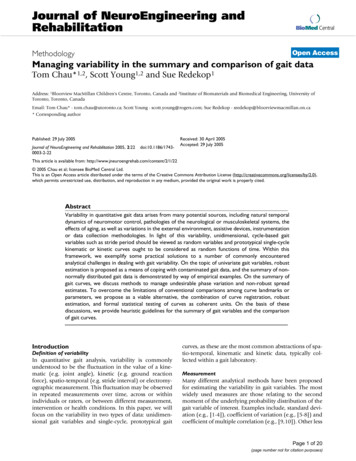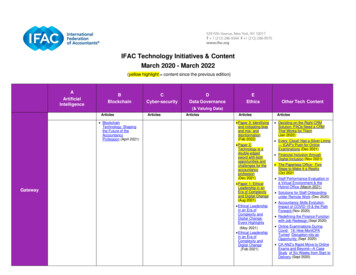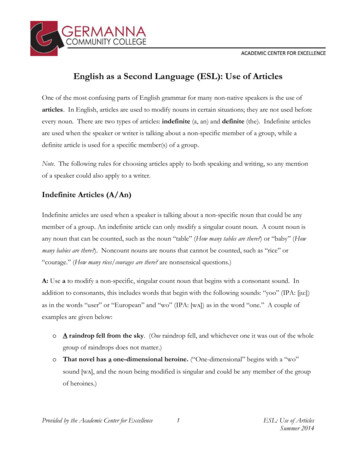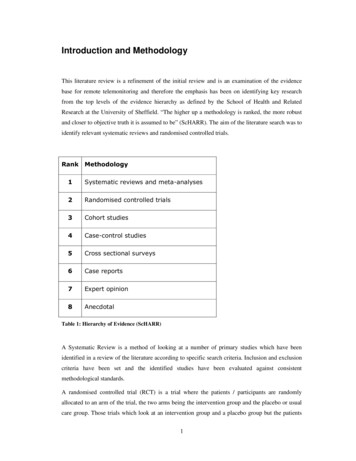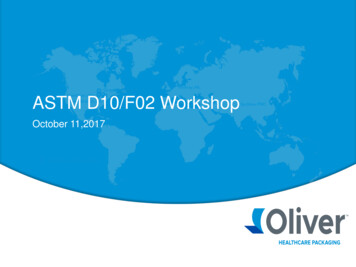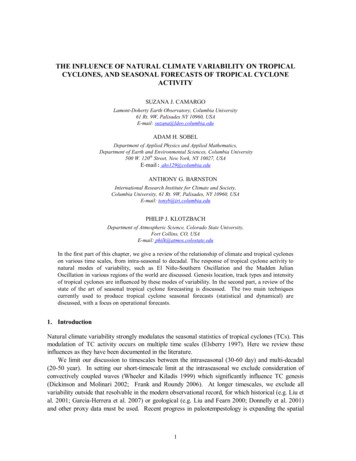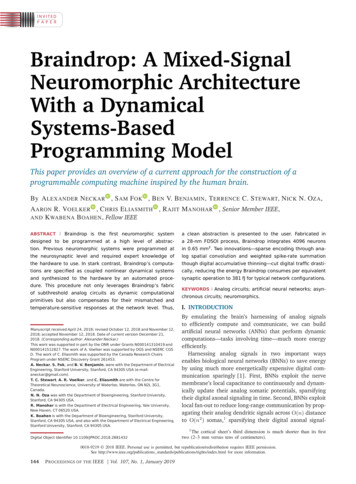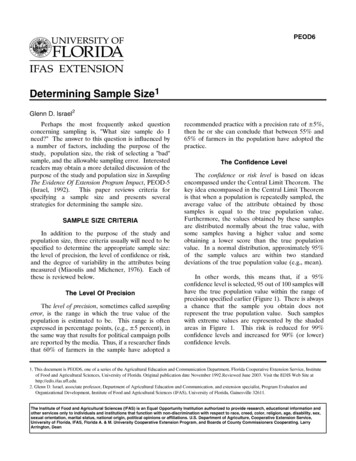
Transcription
RESEARCH ARTICLESVariability of ionospheric total electron contentat low-latitude station during twin solarmaxima and solar minima of the 24th solarcycle and its comparison with different versionsof IRI modelsMahesh Parwani1,*, Azad Ahmad Mansoori2, P. K. Sharma3 and P. K. Purohit41Department of Physics, Barkatullah University, Bhopal 462 026, IndiaDepartment of Physics, Govt. P.G. College, Tikagarh 472 001, India3Barkatullah University Institute of Technology, Barkatullah University, Bhopal 462 026, India4National Institute of Technical Teachers’ Training and Research, Shamla Hills, Bhopal 462 002, India2In this study, we compared the modelled total electroncontent (TEC), i.e. ionospheric TEC derived from thelatest International Reference Ionosphere (IRI) versions(viz. IRI-2007, IRI-2012 and IRI-2016) with TEC derived by the International GNSS Service (IGS) receiversat a low-latitude station, namely Pathum Wan, Thailand(code-CUSV; lat. 13.74 N, long. 100.54 E) during thetwin solar maxima 2012 and 2014, and the solar minima2017 of the 24th solar cycle. We observed that themodelled TEC results were slightly underestimatedthan those derived by global positioning system (GPS),during the maxima and minima periods. It was alsoobserved that the modelled TEC and GPS TEC followed a similar sinusoidal pattern with crests in theequinox months and troughs in the solstice months.We calculated standard deviation of the modelled TECfrom the corresponding GPS TEC during the period.The study shows that the IRI model is more suitablewhen applied during solar minima period. We alsocarried out correlation study between modelled TECand GPS TEC, and obtained a moderate degree ofpositive correlation. Thus we can conclude that IRI2007 is the most suitable version for the twin solarmaxima and the minima periods. Also IRI-2016 is themost suitable model for TEC estimation during geomagnetic storms.Keywords: Geomagnetic storms, ionosphere, low-latitude station, solar cycle, total electron content.NOWADAYS, many empirical models are being used toenhance the applicability of several scientific phenomenaworldwide. Some of the commonly used empirical models are the Model for Earth’s Atmosphere, InternationalGeomagnetic Reference Field and Model for Earth’sMagnetic Field, etc. The ionospheric counterpart of these*For correspondence. (e-mail: maheshkp.007.mp@gmail.com)CURRENT SCIENCE, VOL. 121, NO. 11, 10 DECEMBER 2021models is the International Reference Ionosphere (IRI). Itis a globally recognized and accepted empirical model.This model was developed by the Committee on SpaceResearch (COSPAR) and the International Union of RadioScience (URSI). It is a convenient gateway to specific ionospheric plasma parameters based on reliable data sources.Since the origin of the IRI model in 1969, it has been sustainably upgraded with the latest datasets and the advancemodelling techniques1. It had achieved great successalong the way from the first version IRI-78 (ref. 2) to thelatest version IRI-2016. During the course of time IRI-85,IRI-1990, IRI-2000, IRI-2007 and IRI-2012 versions havealso been developed. The model provides monthly average of electron temperature and density, ion temperatureand composition, including many other parameters froman altitude of 60–1500 km. It consists of a network of ionosondes around the globe that monitor ionospheric electrondensities and the incoherent scatter radars that monitorplasma temperature, velocities and densities of the ionosphere. Unlike the theoretical model, working on the IRImodel does not require any special understanding of theprocesses that constitute ionospheric plasma. The majordrawback of the IRI model is that its results are dependent on the underlying database, which diminishes its reliability. Also, the regions and time periods are not welldepicted in the database and these shortcomings reducethe accuracy of the model. This model is best suited, whenapplied to the continental mid-latitude region of the northern hemisphere, where we have the highest density of ionosondes. It is least suitable, when applied to the oceanareas where penetration of ionosondes is the least. Thismodel is continuously upgraded with periodic workshops,wherein latest results are discussed and decisions aboutfurther updating are made. During the workshop at theUS Air Force Academy in Colorado in 2009, a new effortwas initiated to develop real-time IRI (RT-IRI)3. The worldwide data are gathered from the ground-based ionosondes,1417
RESEARCH ARTICLESand space-based or satellite observations are used to improve the IRI model. As the result, we periodically get upgraded versions with advance features. For instance, theIRI-2016 model was updated with the latest parametersF2 peak height hmF2 and better representation of topsideion densities. The modification provides excellent opportunity to predict evening peak, which was not offered byprevious versions. A significant modification has beenmade in the ion composition model, by lowering topsideionosphere transition height from 1000 to 600 km. Somefeatures of solar indices data are also refurbished in thelatest version4. The electromagnetic radiation of the sunionizes the atmosphere and produces electron and positive ions that spread from 50 to 1000 km (ref. 5). Theseelectrons and positive ions are generally equal in number,which forms an electrically neutral medium. This regionis called ionosphere. It is responsible for ground-to-groundradio communication over long distances by means of thereflection of signals6. Ionosphere being a refractive mediumalso affects the propagation of trans-ionosphere electromagnetic signals that are responsible for ground-to-spaceradio communication. The global positioning system(GPS) signals on traversing through the ionosphere beartwin effect. It accelerates the propagation of carrier phasecalled phase advancement and slows down the propagation of codes by the same amount called group delay. Thistime delay is proportional to the density of electrons fromthe receiver to the satellite. The electron density in a unitcross-section area from the satellite to the receiver isknown as slant total electron content (TEC). It is inverselyproportional to the square of the frequency of propagation7–10. When the GPS signals pass through the ionosphere, they bear the signatures of this volatile medium.Thus the analysis of these signals provides informationabout the density of the constituents. With these results,global maps of ionospheric TEC are prepared for futurereferences11. In the last few decades, ionospheric TEC derived using IRI models and GPS satellites have been globallycompared to estimate the performance of the IRI model atdifferent latitudes, seasons and time periods. On the basisof these studies many theories have been established thatprovide an opportunity to estimate the performance ofvarious IRI models12,13. Some of the theories claim thatIRI model overestimates seasonal and monthly TEC variations during both high and low solar activity periods. Somestudies claim that performance of the model is better during low solar activity period than high solar activity period14. It was also reported that modelled TEC and GPSTEC show better correlation in high-latitude regions than atlow- or mid-latitude regions4. Some researchers found thatthe modelled TEC data shows variation from corresponding data derived from IRI models15–17.Due to our extensive dependency on GPS-based applications, precise predictions of ionospheric TEC are imperative for trouble-free GPS communication and ranging.For this, continuous technical upgradation and mathema1418tical modelling are needed18; but there are some limitations with GPS-based estimation techniques. The first isthe limited number of IGS stations; most of them arespread in the northern hemispheric region only. The otherlimitation is the numerous errors and biases which occurwhen the signals travel over large distances, i.e. 20,200 kmfrom the satellite to the receiver. So there is an urgent needamong the scientific community to develop alternative, reliable, ground-based models for the study of the ionosphere. Thus, we opted to study the IRI model and themain aim of this study was to choose the best version ofthe IRI model. The reason for this is to estimate TEC variability during twin solar maxima 2012 and 2014 and solarminima 2017, so that the suitable version can be appliedwhen GPS data are scarcely available.Data description and analysisThe study was carried out with three types of datasets:ionospheric TEC data derived by GPS, TEC data derivedby IRI model and geomagnetic index data (viz. Dst index(disturbance storm time index) and Bz component of interplanetary magnetic field) downloaded from Space PhysicsData Facility OMNI website (http://omniweb.gsfc.nasa.gov/). We had considered a low-latitude IGS (International GPS Service) station, namely Pathum Wan, Thailand(code-CUSV), lat. 13.74 N and long. 100.54 E. For timereferences, universal time (UT) was considered.Ionospheric TEC derived by GPSWe compared the modelled TEC with GPS-derived TEC(CUSV VTEC) during twin solar maxima 2012 and 2014and solar minima 2017 of the 24th solar cycle. The GPSderived TEC data of the chosen station were obtainedfrom GPS receivers spread across the world and recordeddata at periodic intervals. These recorded data are madefreely available to all users by IGS. The data can bedownloaded from http://sopac.ucsd.edu/dataArchive/. Thedata are provided in RINEX (receiver independent exchange) format, which is an internationally accepted dataexchange format. It is in the standard ASCII format (i.e.readable text). The temporal resolution of the data iscommonly 30 sec. The downloaded raw data were furtherprocessed using the scientific software developed by GopiKrishna Seemala (Indian Institute of Geomagnetism(IIG), Navi Mumbai, India). This software reads the rawdata from international GNSS Services (IGS) code fileand provides the final readable data for further analysis19–21.TEC data obtained from International ReferenceIonosphereIRI is a standard empirical model of the ionosphere. Themodel gives average values of electron content, electronCURRENT SCIENCE, VOL. 121, NO. 11, 10 DECEMBER 2021
RESEARCH ARTICLEStemperature and its density, ion temperature and ioncomposition as a function of local time, position andheight22. In the present study, we have chosen IRI-2007,IRI-2012 and IRI-2016 models for comparison with GPSTEC. It is an international project sponsored by COSPARand URSI. The IRI model calculates TEC by integratingelectron density profile from a lower boundary to thespecified upper boundary. According to the recommendations of CCIR (option for continental areas) and URSI(option for over-the ocean areas)23,24, in this study wehave examined the discrepancies between various IRImodels and GPS observations. We have used TEC fromvarious IRI models at the Pathum Wan station.The on-line IRI model data for the considered versionswere downloaded from http://irimodel.org/. We chose theupper boundary altitude 2000 km topside electron densityoption NeQuick and ABT 2009 for bottom thickness asthe input parameter.Geomagnetic indexIn the present study, we have chosen Dst index to observegeomagnetic storms during the twin solar maxima and solarminima. Geomagnetic storm is a period of significantenergy transfer from solar wind to magnetosphere. Thisenergy transfer reshapes the magnetosphere; this reshaping process is known as geomagnetic storm. It depends ona number of factors such as solar wind speed, orientation ofIMF Bz and its impact on the magnetosphere. The intensity and occurrence of a geomagnetic storm are measuredon the Dst scale. Its quiet time value is between 20 to–20 nT. Further decrease in values indicate weakenedgeomagnetic field. On the Dst scale, geomagnetic stormscan be classified as moderate (–50 to –100 nT), intensestorm (–100 to –250 nT) and super storms (more than–250 nT). Another important factor is the interplanetarymagnetic field (IMF). It is an important component in solarwind interaction with the geomagnetosphere. IMF is avector quantity that has three components, Bx, By and Bz.Bx and By are not important for auroral activity as theyare oriented parallel to the ecliptic, but Bz being perpendicular to the ecliptic is important for the study of geomagnetic storms. The southward magnetic field component Bzexhibits transfer of solar wind energy into the magnetosphere of the Earth. The southward IMF Bz is responsiblefor geomagnetic storms. We have downloaded the indicesdata from the Space Physics Data Facility OMNI (http://omniweb.gsfc.nasa.gov/). These are a daily data that candirectly be used for the study of storms.Results and discussionThe ionospheric TEC variation found to be related withthe changing solar phases. To study the consistency of themodelled TEC during these phases, we compared the modCURRENT SCIENCE, VOL. 121, NO. 11, 10 DECEMBER 2021elled TEC with GPS TEC during the twin solar maxima2012 and 2014 and solar minima 2017 of the 24th solarcycle over the low-latitude station Pathum Wan.Monthly variation of VTEC and performance of theIRI modeFrom Figure 1 we can observed that IRI-2007, IRI-2012and IRI-2016 versions show synchronous variation withGPS-derived TEC during the twin solar maxima and solarminima, over the low-latitude station. It was found that themodelled TEC results were a little underestimated compared to the GPS-derived TEC most of the time, but during summer solstice (June–August), the modelled TECresults were little overestimated.It was also observed that during the twin maxima andminima periods, the IRI-2007 model gave the highestvalues of TEC compared to the other two versions. It wasalso observed that the modelled TEC and GPS TEC recorded the highest monthly VTEC during March–April andOctober, and minimum monthly VTEC during January andJuly. That is, the modelled TEC and GPS TEC followed asimilar sinusoidal pattern with crests in the equinoxmonths and troughs in the solstice months25,26. The ionospheric TEC is controlled by solar photoionization andrecombination processes. The sub-solar points movearound the equator during the equinoctial period. It canbe predicted that the peak in photoelectrons and existenceof eastward electric field are potential causes of higherVTEC peaks during equinox. On the other hand, duringsolstice months, the sub-solar points move up to higherlatitudes. Moreover, the change in the direction of neutralwinds causes lower peaks in during solstice.Annual variation of VTEC and performance of theIRI modeFigure 2 shows the annual variation in GPS-derived TECand modelled TEC during the twin solar maxima 2012and 2014 and solar minima 2017 at Pathum Wan. It canbe observed from the figure that the model underestimates the TEC values during that period, but the similarityin the shape of the curves exhibits visual synchronization27. Also, the curves reached their trough and crestalmost during the same period of time, i.e. a similar sinusoidal pattern was followed by the curves. However, themagnitudes of both modelled TEC and GPS TEC weredifferent. It was noticed that highest annual values ofGPS TEC and modelled TEC were obtained during solarmaximum 2014 and lowest values were obtained duringsolar minimum 2017. This is because during solar minimaperiods, less solar radiation is received by the Earth,which leads to less ionization. While during the solarmaxima periods, higher amount of solar radiation isreceived by the Earth leading to higher ionization.1419
RESEARCH ARTICLESFigure 1.Monthly variability of GPS TEC and modelled TEC during 2012, 2014 and 2017 at the low-latitude station Pathum Wan, Thailand.Figure 2.1420Annual variability of GPS TEC and modelled TEC during 2012, 2014 and 2017 at the low-latitude station Pathum Wan.CURRENT SCIENCE, VOL. 121, NO. 11, 10 DECEMBER 2021
RESEARCH ARTICLESStatistical study of the annual variation of modelledTEC with GPS TECFigure 3 shows the standard deviation (STD) of the considered IRI versions over Pathum Wan station for 2012,2014 and 2017. We have statistically analysed daily averaged data and calculated standard deviation of the modelled TEC from the corresponding GPS TEC. From thefigure, it can be observed that during twin solar maximum period, the modelled TEC exhibits wider spreadrange of STD than that of the solar minimum period. Thespread range of STD was 0–9 TECU during 2012, 0–16TECU during 2014 and 0–7 TECU during 2017. It is inferred that the STD spread range is least during the solarminimum 2017. In other words, the STD yields highernumeric values during solar maxima period and lowervalues during solar minima period. From the analysis, itcan be concluded that the IRI model is more suitablewhen applied during solar minima period.To quantify the association between GPS TEC andmodelled TEC, we statistically analysed daily averagedVTEC data and calculated correlation between modelledTEC and GPS TEC for the twin solar maxima and minimaperiods (Figure 4). It was observed that GPS TEC andmodelled TEC showed a moderate degree of positive correlation during that period. We applied suitable statisticaltools and found correlation coefficients between GPSTEC and IRI-2007, IRI-2012 and IRI-2016 to be 0.706,0.657 and 0.685 respectively, during solar maxima 2012.The correlation coefficients were 0.576, 0.583 and 0.570respectively, during solar maxima 2014 (ref. 28) and 0.606,0.570 and 0.579 respectively, during solar minima 2017.From the results, it can be inferred that IRI-2007 is thebest version for 2012 and 2017 and the second best version (after IRI-2012) for the year 2014. Broadly, it can beconcluded that IRI-2007 is the most suitable version forVTEC studies.During the storm period, the variability of GPS TECseems to be connected to the variability of Dst and Bz.It can be seen from Figure 5 that during the storm period,when Dst dips to a negative value (Dst –50 nT), GPSTEC exhibits significant fluctuation. It is also observedthat both IRI-2007 and IRI-2016 respond to the geomagnetic storms, as seen from the fluctuation during thestorm periods. It can be noticed that IRI-2016 respondsbetter among the considered versions during the solarmaximum 2012. On the contrary, the IRI-2012 modelgives a smooth curve or registers a very weak response tothe storms.Geomagnetic storms during solar maxima 2014: It wasobserved that during the solar maxima 2014, three moderate storms had occurred. All the storms are shown bythe trough in Dst graph (Figure 6) and also by the southward movement of Bz (or negative values of IMF Bz).The strongest storm occurred on 19 February 2014 (50thday of the year) with Dst-66 nT. We also monitored IMFBz during the storm period and noted that its value was 0.6 nT on 17 February 2014, suddenly which dipped to–1.8 nT on 19 February 2014. This sudden reduction inthe positive of IMF Bz and turning it into a negative valueindicates Bz movement from northward to southward direction. The southward IMF Bz is primarily responsible forgeomagnetic storms. During the storm period, the variability of GPS TEC is connected to the variability of Dstand Bz.VTEC variation during geomagnetic storms andperformance of the IRI modelGeomagnetic storms during solar maxima 2012: It wasobserved that during the solar maxima 2012, totally 11storms had occurred. These storms are indicated byDst –50 nT, and also by the southward movement of Bz(or negative values of the Bz component). They all fall inthe category of moderate storms. The strongest amongthese storms occurred on 10 March 2012 (69th day of theyear) with Dst-98 nT. These storms are shown by thetrough in the Dst graph (Figure 5). We also monitoredIMF Bz component during the storm period and observedthat its value was –0.1 nT on 7 March 2012. The value dipped suddenly to –4.6 nT on 10 March 2012, indicatingstrong southward Bz movement. Again during the recovery phase Bz value returned to 0.7 nT on 12 March 2012.CURRENT SCIENCE, VOL. 121, NO. 11, 10 DECEMBER 2021Figure 3. Standard deviation of International Reference Ionosphere(IRI) model from the corresponding GPS TEC over Pathum Wan stationfor 2012, 2014 and 2017.1421
RESEARCH ARTICLESFigure 4.Scatter plot and correlation of GPS TEC with IRI-2007, IRI-2012 and IRI-2016 during 2012, 2014 and 2017.It is clear from Figure 6, that during the storms, whenDst dips to a negative value (Dst –50 nT), GPS TEC andmodelled TEC produce significant fluctuations. The fluctuations are more prominent in GPS TEC graphs. It wasalso observed that both IRI-2007 and IRI-2016 respondedto the geomagnetic storms, as observed from the fluctuations during the storm periods. It can be inferred that IRI2016 responds better than the other versions consideredduring the solar maximum 2014. It was also noticed thatIRI-2012 produced a fluctuation-free curve during thestorm period, or it responded poorly to the occurrence ofstorms.Figure 5. Comparison of variability of GPS TEC and modelled TECwith the geomagnetic indices during solar maxima 2012.1422Geomagnetic storms during solar minima 2017: It wasobserved that during the solar minima 2017, three moderate and one intense storms, i.e. totally four geomagneticstorms had occurred. They are shown by the trough in Dstgraph (Figure 7) and also confirmed by southward movement of Bz (or negative values of the Bz component). Anintense storm occurred on 8 September 2017 (251th dayof the year) with Dst-107 nT. We also monitored IMF Bzduring the storm period and observed that its value was 0.5 nT on 7 September 2017, which suddenly dipped toCURRENT SCIENCE, VOL. 121, NO. 11, 10 DECEMBER 2021
RESEARCH ARTICLES–3.2 nT on 8 September 2017, indicating strong southward Bz movement. Again during the recovery phase, theBz value returned to 0.5 nT on 9 September 2017. Thepositive value indicates that the Bz component hadreturned to the northward direction. During the storm period, the variability of GPS TEC seems to be connected tothe variability of Dst and Bz. It is clear from the Figure 7that the during storm period, when Dst dips to a negativevalue (Dst –50 nT), GPS TEC exhibits significant fluctuation. From the figure, it can be observed that both IRI2007 and IRI-2016 respond almost in a similar manner tothe geomagnetic storms during the solar minima 2017.Also IRI-2012 produced a fluctuation-free curve duringthe storm period. In other words, it responded poorly tothe occurrence of storms.positive correlation during the study period. It can beconcluded that IRI-2007 is most suitable version.ConclusionWe studied the variation of ionospehric TEC and performance of the IRI model during the twin solar maxima2012 and 2014 and solar minima 2017 of the 24th solarcycle over low-latitude station. The main conclusionsdrawn from the study are presented as below:(i) It was observed that the modelled monthly TECresults were underestimated most of the time. It was alsoobserved that during the twin maxima and minima periods,the IRI-2007 model yielded slightly higher values than theother two versions. It was also observed that the modelledTEC and GPS TEC recorded the highest monthly VTECduring March–April and October, and minimum monthlyVTEC during January and July. In other words, the modelled TEC and GPS TEC followed a similar pattern withcrests in the equinox months and troughs in the solsticemonths.(ii) It was found that modelled TEC results were a littleunderestimated than that of the GPS-derived TEC most ofthe time. However, during summer solstice (June–August),the modelled TEC results were little overestimated.(iii) On analysing the annual VTEC data during thestudy period, it was observed that the model underestimates TEC values during the period, but the similarity inthe shape of the curves exhibits visual synchronization. Itwas observed that the curves achieved their trough andcrest almost during the same period of time, i.e. a similarsinusoidal pattern was followed by the curves.(iv) It was also observed that highest diurnal values ofGPS TEC and modelled TEC were obtained during thesolar maxima 2014 and lowest diurnal values during thesolar minima 2017.(v) We calculated standard deviation of modelled TECfrom the corresponding GPS TEC during the study period.It can be concluded that the IRI model is more suitablewhen applied during the solar minima period than the solar maxima period.(vi) We carried out correlation study between modelledTEC and GPS TEC, and obtained a moderate degree ofCURRENT SCIENCE, VOL. 121, NO. 11, 10 DECEMBER 2021Figure 6. Comparison of variability of GPS TEC and modelled TECwith the geomagnetic indices during solar maxima 2014.Figure 7. Comparison of variability of GPS TEC and modelled TECwith the geomagnetic indices during solar minima 2017.1423
RESEARCH ARTICLES(vii) It was observed that during the storm period, thevariability of GPS TEC is connected to the variability ofDst and IMF Bz indices.(viii) Thus it can be concluded that IRI-2016 is mostsuitable version for TEC estimation, especially duringgeomagnetic storm periods.1. Bilitza, D., Hernandez-Pajares, M., Juan, J. M. and Sanz, J., Comparison between IRI and GPS–IGS derived electron content during1991–97. Phys. Chem. Earth, 1999, 24(4), 311–319.2. Bilitza, D. and Rawer, K., International reference ionosphere –past, present and future: electron density. Adv. Space Res., 2013,13(3), 3–13.3. Bilitza, D., Lee-Anne, M., Bodo, R. and Tim, F. R., The international reference ionosphere today and in the future. Geod. J.,2011, 85, 909–920; doi:10.1007/s00190-010-0427.4. Wang, X., Wan, Q., Maruyama, T., Guanyi, M. A., Jinghua, L. I.and Jiangtao, F., Comparison of global TEC between IRI TEC andGPS TEC in the spring of 2006. In 32nd Union Radio ScientifiqueInternational General Assembly and Scientific Symposium, Montreal, Canada, 19–26 August 2017.5. Kelley, M. C., The Earth’s Ionosphere: Plasma Physics and Electrodynamics, Elsevier, New York, USA, 2009, 2nd edn, p. 545.6. Hunsucker, R. D. and Hargreaves, R. D., The High-Latitude Ionosphere and its Effects on Radio Propagation, Cambridge UniversityPress, Cambridge, UK, 2003.7. Hofmann-Wellenhof, B., Lichtenegger, H. and Collins, J., GlobalPositioning System Theory and Practice, Springer-Verlag Wien,New York, USA, 1992, pp. 289–311.8. Misra, P. and Enge, P., Global Positioning System: Signals, Measurements, and Performance, Ganga-Jamuna Press, Lincoln, USA,2006, pp. 200–218.9. Hansen, A., Blanch, J. T. and Walter, T., Ionospheric correctionanalysis for WAAS quiet and stormy. In Proceedings of the 13thInternational Technical Meeting of the Satellite Division of TheInstitute of Navigation Global Positioning System, Salt Lake City,Utah, USA, 2000, pp. 19–22.10. Lanyi, G. E. and Roth, T., A comparison of mapped and measuredtotal ionospheric electron content using global positioning systemand Beacon satellite observations. Radio Sci., 1988, 23(4), 483–492.11. Bilitza, D., International reference ionosphere 2000. Radio Sci.,2001, 36(2), 261–275.12. Kumar, S., Tan, E. and Murti, D., Impacts of solar activity onperformance of the IRI-2012 model predictions from low to midlatitudes. Earth Planets Space, 2015, 67, 42; doi:10.1186/s40623015-0205-3.13. Ezquer, R. G. et al., Behaviour of ionospheric magnitudes of F2region over Tucumán during a deep solar minimum and comparison with the IRI 2012 model predictions. J. Atmos. Sol.-Terr.Phys., 2014, 107, 89–98.14. Asmare, Y., Tsgaye, K. and Melssew, N., Validation of IRI-2012TEC model over Ethiopia during solar minimum (2009) and solarmaximum (2013) phases. Adv. Space Res., 2014, 53, 2.017.15. Abdu, M. A., Batista, I. S. and Souza, J. R., An overview of IRIobservational data comparison in American (Brazilian) sector lowlatitude ionosphere. Adv. Space Res., 1996, 18(6), 13–22.142416. Kumar, S., Performance of IRI-2012 model during a deep solarminimum and a maximum year over global equatorial regions.J. Geophys. Res., Space Phys., 2016, 121, 394; doi:10.1002/2015JA022269.17. Tariku, Y. A., Patterns of GPS-TEC variation over low-latituderegion (African sector) during the deep solar minimum (2008 to2009) and solar maximum (2012 to 2013) phases. Earth PlanetsSpace, 2015, 67, 35; doi:10.1186/s40623-015-0206-2.18. Tariku, Y. A., Variability of TEC and improvement of performance of the IRI model over Ethiopia during the high solar activityphase. Ann. Geophys. Discuss., 2018, 48; https://doi.org/10.5194/angeo-2018-48.19. Mahesh, P., Roshni, A., Shweta, M. and Purohit, P. K., Latitudinalvariation of ionospheric TEC at northern hemispheric region.Russ. J. Earth Sci., 2019, 19, 1; doi:10.2205/2018ES000644.20. Olawepo, A. O., Oladipo, O. A., Adeniyi, J. O. and Doherty, P. H.,TEC response at two equatorial stations in the African sector to geomagnetic storms. Adv. Space Res., 2015, 56(1), 19–27.21. Hamzah, S. Z. M. and Homam, M. J., The correlation between totalelectron content variations and solar activity. ARPN J. Eng. Appl.Sci., 2015, 10(20).22. Bilitza, D. et al., The International Reference Ionosphere 2012 – amodel of international collaboration. J. Space Weather Space Climate, 2014, 4, A07.23. Rush, C., Fox, M. and Bilitza, D., Ionospheric mapping – anupdate of foF2 coefficients. Telecommunications J., 1989, 56,179–182.24. Aggarwal, M., TEC variability near northern EIA crest and comparison with IRI model. Adv. Space Res., 2011, 48(7), 1221–1231.25. Roshni, A., Azad, A. M., Parvaiz, A. K. and Rafi, A., Study of ionospheric TEC variability over low, mid and high latitudes duringsolar maximum and its comparison with IRI-2012 and IRI-2016model. Astronom. Astrophys. Trans., 2017, 30(2), 223–232.26. Tariq, M. A., Shah, M., Inyurt, S., Shah, M. A. and Liu, L., Comparison of TEC from IRI-2016 and GPS during the low solaractivity over Turkey. Astrophys. Space Sci., 2020, 365, 179.27. Jumpon, U., Supnithi, P., Phakphisut, W., Hozumi,
3Barkatullah University Institute of Technology, . 4National Institute of Technical Teachers' Training and Research, Shamla Hills, Bhopal 462 002, India In this study, we compared the modelled total electron content (TEC), i.e. ionospheric TEC derived from the . US Air Force Academy in Colorado in 2009, a new effort was initiated to .
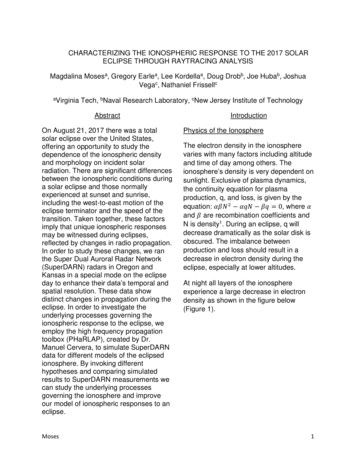
![High Variability [Pronunciation] Training (HVPT)](/img/28/2018thomson-hvpt.jpg)
